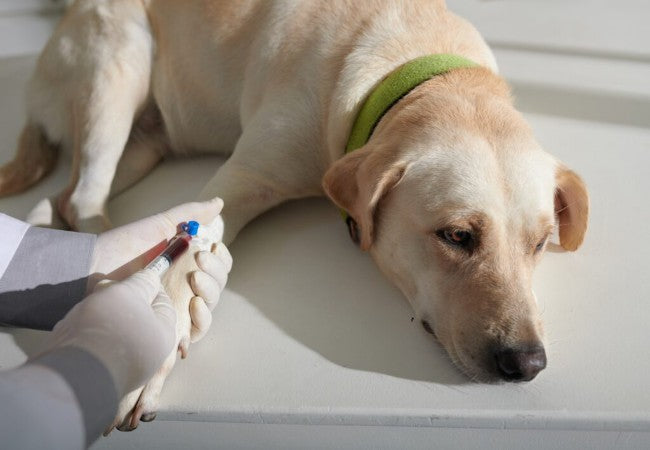Overproduction of White Blood Cells in Dogs – Vet Guide 2025 🐾🩸🩺

In this article
WOverproduction of White Blood Cells in Dogs – Vet Guide 2025 🐾🩸🩺
By Dr. Duncan Houston BVSc
Hello! I’m Dr Duncan Houston, BVSc, founder of Ask A Vet. When your dog's complete blood count (CBC) shows an elevated white blood cell (WBC) count—leukocytosis or leukogram abnormalities—it often signals a deeper health issue, from infection to bone marrow disorders. Overproduction of WBCs may be reactive and harmless, or it may indicate serious conditions like leukemia. This in-depth 2025 guide will walk you through causes, clinical signs, diagnostic strategies, treatment options, monitoring plans, and home care for lifelong wellness.
📘 What Is Leukocytosis?
Leukocytosis means an increased total number of circulating WBCs—neutrophils, lymphocytes, monocytes, eosinophils, or basophils. The type and proportion of cells elevated helps clarify the underlying cause. Leukopenia, the opposite, signals reduced WBCs.
🧬 Causes & Patterns
- Neutrophilia: Often from infection (bacterial, fungal) or inflammation; may involve immature “left shift” cells.
- Eosinophilia: Linked to parasites, allergies, or hypereosinophilic syndrome—an idiopathic bone marrow overproduction sometimes seen in breeds like Rottweilers, GSDs, Cavaliers.
- Lymphocytosis: Seen in chronic infections, immune stimulation, or lymphoid cancers like lymphoma/leukemia.
- Monocytosis: Indicative of chronic inflammation or tissue breakdown.
- Basophilia: Rare, often seen in allergic or parasitic conditions like heartworm.
- Myeloproliferative/Neoplastic disorders: Disorders where bone marrow overproduces abnormal leukocytes, as in leukemia or MPDs.
🚩 Signs & Presentation
- Signs vary by cause: fever, lethargy, appetite loss, lymph node swelling, coughing, GI upset, organ enlargement, bleeding, or bone marrow suppression. Hypereosinophilic forms may cause hepatitis, organomegaly, and lesions.
- Bone marrow cancers may present with cytopenias: anemia, thrombocytopenia, or neutropenia.
- Dogs with extreme neutropililica (ENL) may show severe illness—high mortality, but disease-dependent prognosis.
🔬 Diagnostic Workflow
- CBC with differential & smear: evaluates total WBC, cell types, left‑shift, toxicity.
- Morphology: toxic changes, blasts, or atypical cells may suggest leukemia or inflammation.
- History & exam: infection signs, organ enlargement (spleen, nodes), bleeding, etiology clues.
- Bone marrow aspiration/biopsy: essential for diagnosing leukemias, MPDs, and marrow response.
- Imaging: X‑rays/ultrasound to evaluate organ involvement or lymphadenopathy.
- Advanced testing: Flow cytometry, PARR, cytogenetics for clonal disease differentiation.
- Infectious screens: Tick-borne diseases (Ehrlichia, Lyme), viral/fungal panels.
💊 Treatment & Management
1. Reactive/Infectious/Inflammatory
- Antimicrobials tailored to the infection (e.g., antibiotics, antifungals).
- Anti-inflammatory therapy: NSAIDs or corticosteroids.
- Treat underlying cause—abscesses, parasites, immune conditions, and allergy control.
2. Hypereosinophilic Syndrome
- Immunosuppressive doses of corticosteroids ± chemo agents.
- Supportive care: fluid therapy, manage liver/spleen involvement.
- Regular monitoring of CBC and organ function.
3. Neoplastic Forms (Leukemia/MPD)
- Cancer therapy: chemotherapy, targeted agents, and sometimes radiation.
- Supportive transfusions (RBCs, platelets) for cytopenias.
- Monitor for infection and bleeding risks.
4. Extreme Neutrophilic Leukocytosis (ENL)
Treat the underlying disease; leukocyte count itself doesn’t require removal. Prognosis depends on cause and individual response.
📅 Monitoring & Prognosis
- Frequent CBCs to track WBC trends and treatment response.
- Follow-up imaging or bone marrow re-checks for cancer cases.
- Prognosis varies widely: reactive/transient leukocytosis often resolves; hypereosinophilic syndrome may require lifelong management; leukemia/MPDs have variable but often poorer outcomes.
🏠 Home Care & Support at Home
- Strict medication adherence and monitoring for side effects.
- Maintain hydration and appetite—consider appetite stimulants if needed.
- Protect neutropenic dogs from infection; maintain clean environment.
- Watch for bleeding, lethargy, or any worsening signs—report to vet promptly.
- Emotional care: quiet rest, stress reduction, gentle interaction.
✨ Key Takeaways
- Overproduction of WBCs (leukocytosis) indicates underlying disease—infectious, inflammatory, immune-mediated, or neoplastic.
- Detailed leukogram and smear are essential for identifying which WBCs are elevated.
- Bone marrow biopsy and advanced diagnostics differentiate reactive vs neoplastic causes.
- Treatment may involve antimicrobials, steroids, chemo, or supportive care depending on the diagnosis.
- Prognosis ranges from good (reactive) to guarded (cancerous); early detection improves outcomes.
🐾 Ask A Vet
- Specialist hematology consults and treatment planning through Ask A Vet..
If your dog’s bloodwork shows elevated white blood cells, don’t panic. It’s a signal to dig deeper. Partner with your vet, track diagnostics closely, and implement tailored treatment to address the root cause and restore health. 🩺






